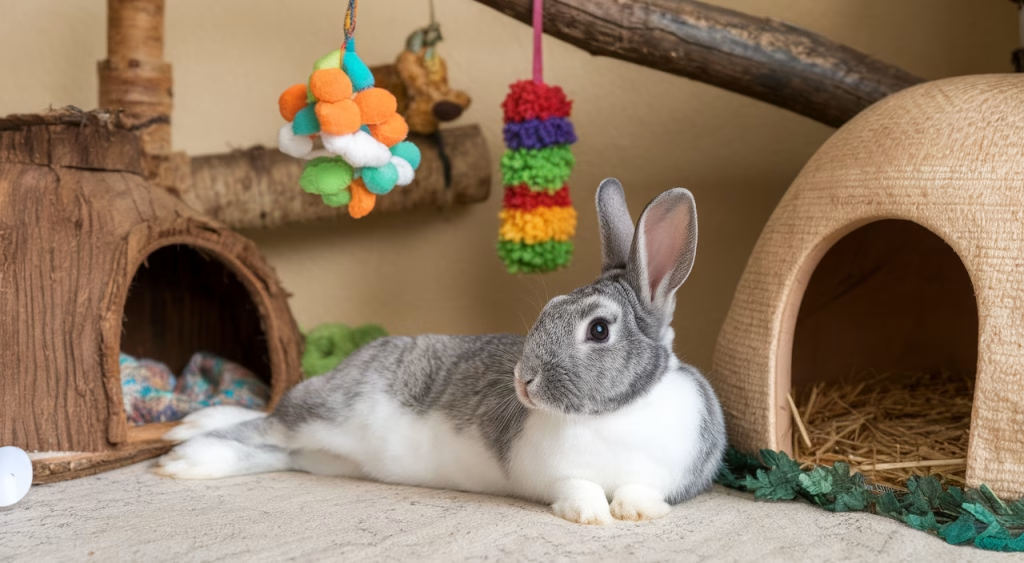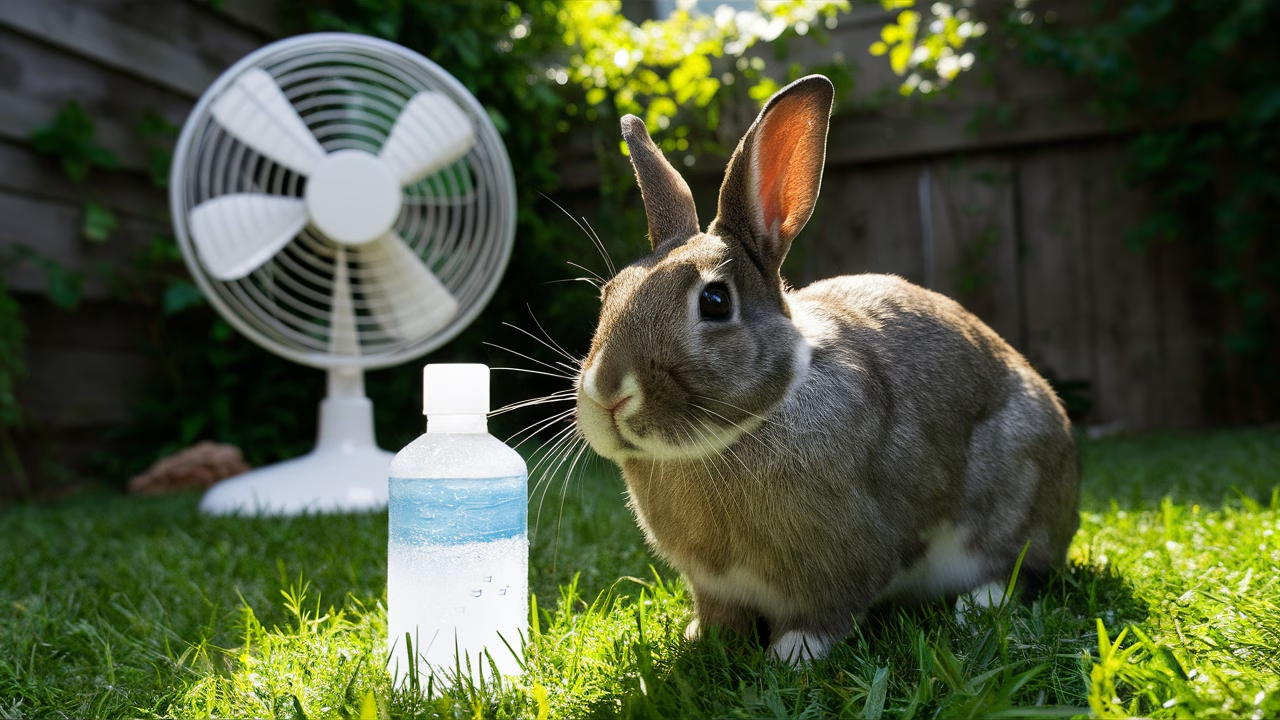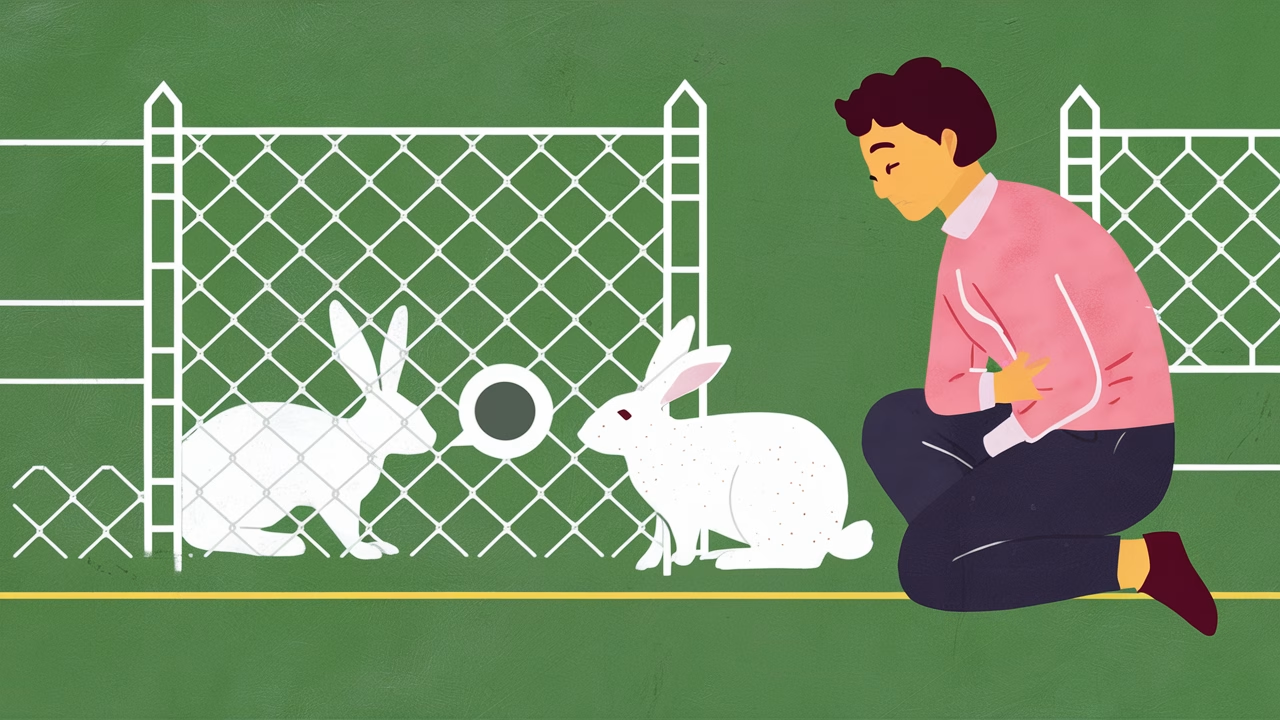What are the most essential tips for proper rabbit care?
Ensuring your rabbit’s well-being means understanding their unique sensitivities, building a safe, comforting environment, fulfilling their social needs, and staying on top of grooming and dietary requirements. These aren’t just pets—they’re companions with complex emotional and physical needs that require dedicated rabbit care.
TL;DR:
- Understand rabbit sensitivities: Rabbits are highly attuned to temperature, sounds, and smells. Keep their environment calm and consistent.
- Safe and enriching housing: Spacious, clean spaces with hiding spots relieve stress and support natural behavior.
- Social interaction: Rabbits are social animals—companionship with another rabbit (or daily human interaction) is important for emotional health.
- Rabbit grooming and care: Regular brushing, a proper diet, and exercise help them stay healthy and happy.
- Enrichment is key: Stimulating toys and engaging activities prevent boredom and behavioral issues.
Understanding Rabbit Sensitivities
As a veterinarian, one of the most common misunderstandings I see is underestimating how delicately tuned rabbits are to their surroundings. Their acute senses make them marvelous in the wild—but that same sensitivity can spell stress in a domestic setting when proper rabbit care isn’t followed.
Temperature Sensitivity and Management
Rabbits cannot sweat—they regulate their body temperature through their ears, which act as natural thermostats. Ever seen a rabbit flop down on a hot day and stretch out? That’s a subtle sign of heat stress. They thrive in temperatures between 60–65°F. Anything above 85°F puts them at serious risk of heatstroke.
- Ensure shaded housing with proper air ventilation during warm months for a safe environment.
- Use ceramic tiles or frozen water bottles wrapped in towels for them to lie against on hot days.
- Daily, cool (not cold!) misting of their ears helps with internal temperature regulation.
Importance of Sense of Smell and Safe Environment
Ever noticed your bunny suddenly bolt for cover? Their powerful noses pick up scents we can’t even detect—but that may spell danger to them. Animals that rely on scent to evade predators react strongly to lingering chemicals or foul environments. Creating a safe environment means being mindful of scents.
Avoid the following scents:
| Scent | Effect |
|---|---|
| Ammonia (from unclean litter) | Respiratory distress, anxiety |
| Vinegar | Triggers defensive behavior |
| Garlic or pepper oils | Creates fear-based scent reaction |
Daily fresh air circulation and clean bedding are key to preventing unwanted smells and promoting relaxation in your rabbit care routine.
Enhancing Comfort with Sharp Hearing Awareness
Rabbits have satellite-like ears, capable of swiveling 270 degrees. While this is great for hunting threats in the wild, in a home, loud or sudden noises can trigger anxiety or even lockdown behavior.
- Keep their habitat away from loud appliances like washing machines or TVs to maintain a safe environment.
- Use soft voices and slow movements when around them.
- Provide white noise or gentle background music to mask stressful sounds like thunderstorms.
Creating a Safe and Stimulating Environment
A rabbit’s home is their haven. It’s not just bedding and bowls—it’s their sanctuary, gym, and playground rolled into one. Proper rabbit care includes thoughtful habitat design.
Housing and Enrichment Tips
A spacious, clean enclosure encourages natural behaviors and forms the foundation of a safe environment. Enclosures should allow your bunny to “binky” (that joyful jump-spin move), stretch out fully, and have room for toys and food areas. For indoor rabbits, bunny-proofing the room is just as essential. Cover wires, block tight spaces, and use chew-safe materials.
Here’s what to include in your rabbit care setup:
- Enclosed shelter: A small den-like hideout mimics their natural burrows.
- Chewing toys: Prevent boredom and dental problems with willow sticks or untreated wood chunks.
- Dig boxes: Fill shallow containers with shredded paper or hay for natural digging urges.
Best toys for rabbit mental stimulation include puzzle feeders, tunnels, and interactive treat balls that encourage natural foraging behaviors.
Importance of Cleanliness and Safe Hiding Spots
Ever been in a messy hotel room and instantly felt uneasy? Rabbits feel this tenfold in unclean environments. Their mental health and immune system are directly linked to habitat cleanliness—a crucial aspect of rabbit care.
- Spot-clean urine and droppings daily to maintain a safe environment.
- Fully clean and sanitize enclosures weekly.
- Keep 1–2 constant hiding spots per rabbit, like neutral-smelling tunnels or cardboard castles, untouched by kids or pets.
Healthy Interactions and Companionship
Rabbits are not solitary by nature. In the wild, they thrive in colonies, and their mental health often suffers in solitude. Understanding how to introduce companion rabbits is essential rabbit care knowledge.
Choosing Suitable Companions for Your Rabbit
If you’re considering getting companion rabbits, be patient. Bonding isn’t instant and should always occur under supervision in neutral territory. Expect some grooming, occasional spats, and eventual cuddling—it’s a bit like dating for bunnies.
How to introduce a second rabbit for companionship:
- Use separate cages initially and allow scent-based interaction in a safe environment.
- Begin short bonding sessions where neither feels territorial.
- Look for mutual grooming and relaxed behaviors as success signs in your companion rabbits.
Social Interactions and Stress Reduction Techniques
Like shy toddlers, rabbits warm up over time—forcing socialization pushes them further away. Instead, use patience in your rabbit care approach. Offer treats during interactions, sit quietly on the floor, and allow them to approach you.
Importance of Gentle Handling and Interaction
Holding a rabbit improperly can result in serious injury or panic. Always support the hindquarters, scoop gently from the side, and avoid startling them. Never lift from the ears (a common misconception) or drop from heights—proper handling is fundamental rabbit care.
Essential Care Practices for Overall Well-Being
Good intentions are just the start—daily rabbit care needs precision, understanding, and a lot of love.
Nutritional Needs and Exercise Requirements
A diet rich in hay is non-negotiable in proper rabbit care. Think of hay as their daily bread—it maintains digestive health, trims teeth naturally, and promotes gut motility.
- Offer unlimited timothy or meadow hay daily as part of your rabbit care routine.
- Add leafy greens like romaine, cilantro, or parsley to maintain a safe environment for digestion.
- Limit pellets to under 5% of the diet to prevent obesity.
Rabbits should also enjoy 3–5 hours of active time outside their hutch daily—through tunnels, obstacle courses, or garden romps (supervised of course!).
Rabbit Grooming Tips and Tools for Care
While some breeds like rexes have low-maintenance coats, others like angoras require daily rabbit grooming. Without proper grooming, mats develop, and digestive issues from fur ingestion become a danger.
Essential rabbit grooming tools for fur maintenance:
- Slicker brushes for gentle detangling in your grooming routine
- Rubber grooming mitts for shedding control
- Safe nail clippers designed for small pets
Never bathe a rabbit unless medically necessary. Instead, spot clean dirty fur with a damp cloth and use dry shampoo alternatives only if safe and vet-approved—this is crucial rabbit grooming knowledge.
Why Honeybees Visit 50-100 Flowers Per Trip: The Secret Foraging Behavior Explained
Stress and Anxiety Management Strategies
From vacuum cleaners to unfamiliar guests, stress comes in many forms in rabbit care. Rabbits experiencing anxiety may hide excessively, refuse to eat, or show aggression.
- Create a safe environment with minimal traffic—preferably dim and quiet.
- Watch for triggers and minimize them gradually in your rabbit care routine.
- Offer foraging opportunities and tunnels for stimulating calm behavior.
Respect natural behaviors: Clothing might be fun for pictures but is almost always distressing for rabbits and goes against proper rabbit care.
Frequently Asked Questions
How do I know if my rabbit is stressed?
Signs of stress include hiding, belly pressing, teeth grinding (not purring), aggression, and reduced appetite. Create a quiet, predictable safe environment and remove stressors like loud sounds or overhandling in your rabbit care routine.
Can rabbits be kept in a cage all day?
No, long-term caging can lead to physical and psychological issues. Proper rabbit care requires they have space to move freely and social interaction daily.
Are rabbits good pets for children?
Only under supervision. Rabbits are fragile prey animals requiring gentle rabbit care. Rough handling or unpredictable movements can stress or injure them. Teach gentle behavior early.
Do rabbits need vaccinations?
In some regions, vaccines are essential to prevent deadly diseases like RHDV. Check local veterinary recommendations for your rabbit care plan.
What’s the best flooring for a rabbit enclosure?
Soft, non-slip options like fleece and rubber mats create a safe environment and are easy on their feet. Avoid wire mesh, which can cause sore hocks.
How often should I groom my rabbit?
Short-haired rabbits need weekly rabbit grooming; long-haired breeds may require daily grooming to prevent matting and blockages.
Can I use cat litter in my rabbit’s litter box?
Only if it’s paper-based or wood-pelleted and unscented for a safe environment. Avoid clay or clumping litter—it’s dangerous if ingested and goes against proper rabbit care.





